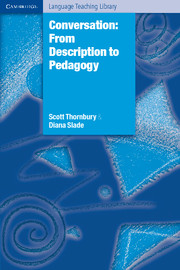Book contents
- Frontmatter
- Contents
- Thanks and acknowledgements
- Dedication
- Introduction
- 1 Characterizing conversation
- 2 The vocabulary of conversation
- 3 The grammar of conversation
- 4 The discourse features of conversation
- 5 Genres in conservation: Storytelling and gossiping
- 6 Acquiring L1 conversational competence
- 7 Acquiring L2 conversational competence
- 8 Teaching conversation: A history
- 9 Teaching conversation: Approach, design, procedure and process
- Task key
- References
- Author index
- Subject index
5 - Genres in conservation: Storytelling and gossiping
Published online by Cambridge University Press: 04 May 2010
- Frontmatter
- Contents
- Thanks and acknowledgements
- Dedication
- Introduction
- 1 Characterizing conversation
- 2 The vocabulary of conversation
- 3 The grammar of conversation
- 4 The discourse features of conversation
- 5 Genres in conservation: Storytelling and gossiping
- 6 Acquiring L1 conversational competence
- 7 Acquiring L2 conversational competence
- 8 Teaching conversation: A history
- 9 Teaching conversation: Approach, design, procedure and process
- Task key
- References
- Author index
- Subject index
Summary
Introduction
In Chapter 1 we described the significance of conversation, arguing that it is a critical site for the maintenance and modification of our social identities. We argued that it both creates and reflects our social worlds and that it is the primary location for the enactment of social values and relationships. And because of its centrality in our daily lives we argued that it ought to be given more prominence in ELT classes. In Chapters 2 to 4, by providing an account of conversational structure at the level of vocabulary, grammar and discourse, we demonstrated that conversation is a highly structured, functionally motivated, semantic activity. In this chapter we will be building on the description outlined in previous chapters, describing conversation at the level of genre. The focus therefore has moved in this chapter from the micro-structure (i.e. the vocabulary and grammar) to the macro-structure (i.e. the overall organization) of casual talk, building up a cumulative description of conversation in the process. We will first describe the different genres that commonly occur in English conversation and then we will describe in detail two of the most frequently occurring genres: storytelling and gossip.
Chat and Chunks in conversation
Here is a segment of naturally occurring conversation. It takes place in the coffee room of a hospital at morning break time. There are four participants: Gary, Pauline, Bron and Pat. They are all clerical staff in the hospital and have worked together for over two years. They are in their mid-to late twenties. (A short segment of this conversation, turns 26–37, was presented in Chapter 4, detailing a move-by-move analysis.)
- Type
- Chapter
- Information
- ConversationFrom Description to Pedagogy, pp. 142 - 185Publisher: Cambridge University PressPrint publication year: 2006



